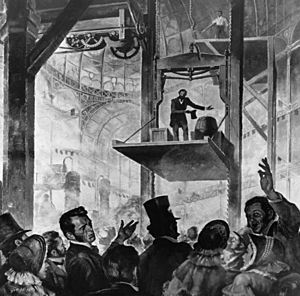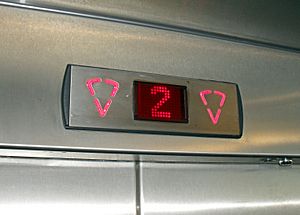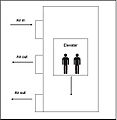Elevator facts for kids
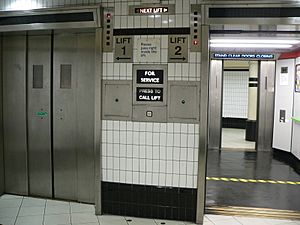
An elevator or lift is a special kind of vehicle that moves people or things up and down inside buildings. Think of it like a moving room that travels between different floors. Most elevators use electric motors. These motors either pull the elevator up with strong cables and a counterweight (a heavy balance), or they use liquid pressure (hydraulics) to push a large rod that lifts the elevator.
In many places, especially in new buildings with many floors, elevators are required by law. This is to make sure everyone, including people using wheelchairs, can easily get to all parts of the building.
Contents
How Elevators Work
Elevators might have started as simple hoists that pulled things up with ropes or chains. Today, a modern elevator has a "cab" (the part you ride in) that sits on a platform. This platform moves inside a special enclosed space called a "shaft" or "hoistway."
In the past, elevators used steam power or water pressure. Now, most use electricity.
Traction Elevators
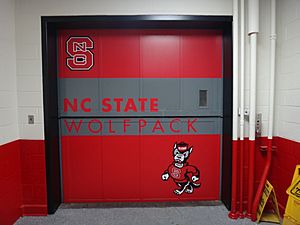
"Traction" elevators are pulled up by strong steel ropes. These ropes go over a deeply grooved wheel called a "sheave." The weight of the elevator cab is balanced by a heavy "counterweight." This counterweight moves down when the cab goes up, and up when the cab goes down. Sometimes, two elevators in the same shaft move in opposite directions, acting as each other's counterweight!
The ropes and the sheave create friction, which is how these elevators get their "traction." This friction is what makes them move.
Hydraulic Elevators
Hydraulic elevators use the power of liquids under pressure. They have a piston (a large rod) that is pushed up by hydraulic fluid, which lifts the elevator cab. These can be underground or above ground. Some hydraulic elevators also use ropes along with the hydraulic power.
Newer elevators use special motors and computer controls. Hydraulic elevators are often cheaper to install, but they are usually slower than traction elevators. They are also not practical for very tall buildings (more than about seven stories) because the piston would need to be too long. For very tall buildings, traction elevators are used instead.
Elevator Doors
Elevator doors are very important for safety. They stop people from falling into the shaft. The most common type has two panels that meet in the middle and slide open to the sides. Some doors slide behind each other, like layers, which allows for wider openings in smaller spaces. Less expensive elevators might have one large "slab" door that slides open to one side.
Machine Room-Less Elevators
Traditionally, elevators needed a special "machine room" to hold large electric motors or hydraulic pumps and control cabinets. This room was usually above or below the elevator shaft.
However, modern motors are smaller and more efficient. This means that some traction elevators can now be built without a separate machine room. This saves valuable space in buildings! These "machine room-less" elevators are a good choice for buildings that are not too tall, from low to medium height. A Finnish company called Kone first created this type of elevator in 1996.
A Look Back: Elevator History
The very first mention of an elevator comes from the Roman architect Vitruvius. He wrote that Archimedes built an elevator around 236 B.C. These early elevators probably used hemp ropes and were pulled by hand or by animals. Some old writings suggest similar elevators were used in a monastery in Egypt. In the 1600s, basic elevators were found in palaces in England and France.
A big step forward happened in 1852 when Elisha Otis introduced the "safety elevator." This invention stopped the elevator cab from falling if the cable broke. He showed how safe it was at an exhibition in New York in 1854. His safety design is still used in some ways today!
Later, in 1874, J.W. Meaker patented a way for elevator doors to open and close safely. The first electric elevator was built by the German engineer Werner von Siemens in 1880.
In 1882, a company in London, England, built a huge network of high-pressure water pipes. This system powered about 8,000 machines, mostly elevators and cranes, across the city.
In 1929, Clarence Conrad Crispen created the first elevator for homes. He also invented the first stairlift, which helps people go up and down stairs.
Elevator Safety
Statistically, elevators are incredibly safe. They have one of the best safety records of any type of vehicle. It's extremely rare for an elevator to simply fall. Most elevator-related accidents involve maintenance workers or people making easily avoidable mistakes, like stepping into an empty shaft.
For example, before a major event in 2001, the only known free-fall incident in a modern cable elevator happened in 1945. A B-25 bomber hit the Empire State Building in fog, cutting the elevator cables. The elevator fell from the 75th floor to the bottom. The only person inside, the elevator operator, was seriously injured but survived.
Modern elevators have many safety features:
- An elevator cab is usually held by six or eight strong cables. Each cable alone can hold the full weight of the elevator plus more.
- There's a device that detects if the elevator is going down too fast. If it does, special brake shoes clamp onto vertical rails in the shaft, stopping the elevator quickly but smoothly.
- A hydraulic buffer (a shock absorber) is installed at the bottom of the shaft to cushion any impact.

In 2007, there was an incident in Seattle where an elevator using special Kevlar fiberglass ropes broke free. After this, the company stopped making that model and switched back to traditional braided-steel ropes, which are much safer.
Pneumatic Vacuum Elevators
Pneumatic or "Vacuum" elevators work without cables. They are easier and faster to install because their parts are pre-made and narrower than regular elevator shafts. These elevators often have clear, see-through sections, giving passengers a nearly 360-degree view.
Types of Hoist Mechanisms
There are several ways an elevator can be moved up and down.
Traction Elevators (More Detail)
- Geared Traction Elevators: These use electric motors and gears to control the movement of the elevator car. They are good for speeds up to about 500 feet per minute.
- Gearless Traction Elevators: These use powerful, slow-speed electric motors directly connected to the drive wheel. They can reach very high speeds, up to 2,000 feet per minute or even faster. A brake system holds the elevator still at a floor. If power fails, the brake engages automatically to prevent the elevator from falling.
In both types, cables are attached to the top or bottom of the elevator cab. These cables loop over the drive wheel and connect to a counterweight. The counterweight helps reduce the power needed to move the cab. It moves in the opposite direction of the cab. The counterweight usually weighs about the same as the empty elevator cab plus 40-50% of its maximum passenger weight.
For very tall elevators (over 100 feet of travel), there's a "compensation" system. This is a separate set of cables or a chain attached to the bottom of both the cab and the counterweight. This system helps balance the weight of the main hoist cables as the elevator moves, making it easier to control.
Hydraulic Elevators (More Detail)
- Conventional Hydraulic Elevators: These use a cylinder that goes underground. They are common in low-rise buildings (2-7 floors) and can travel up to 200 feet per minute.
- Holeless Hydraulic Elevators: Developed in the 1970s, these use cylinders that stay above ground. They are good for buildings with 2, 3, or 4 floors, especially where digging a deep hole is difficult or costly.
- Roped Hydraulic Elevators: These combine above-ground cylinders with a rope system. They offer flexibility and can serve up to 8-10 floors.
Climbing Elevators
A climbing elevator is special because it moves itself up using its own engine (electric or combustion). These are often used in tall towers or masts to help maintenance workers reach high parts, like safety lights.
Emergency Power Operation
Many elevators have emergency power systems. These systems allow elevators to keep working during a power outage, preventing people from getting stuck.
- Traction Elevators with Emergency Power: If power goes out, all elevators will stop. Then, one by one, each elevator will return to the main lobby floor, open its doors, and shut down. People inside will be told that the elevator is returning to the lobby. Once all elevators are back, the system will choose one or more to run on emergency power for normal use.
- Hydraulic Elevators with Emergency Power: When power is lost, hydraulic elevators will go down to the lowest floor and open their doors for passengers to exit. They then close and stay unusable until power is restored.
Elevator Features for Convenience
Elevators often have talking devices to help people who are blind. These devices announce the floor number, the direction the elevator is going, and when the doors are about to close.
Besides call buttons, elevators usually have floor indicators. These might be lights (often LEDs) that show which floor the elevator is on, or they might be LCD screens. You'll see these inside the cab and sometimes outside on different floors. A sound often plays when the elevator changes floors or arrives.
Direction lanterns are also found inside and outside elevators. Their main purpose is to help people waiting decide if they should get on. If you want to go up, but the elevator shows it's going down, you might wait for another one. These lanterns often use arrows or colors (like green for up, red for down).
Most elevators also have a chime sound to tell you if the elevator is going up or down before the doors open. Usually, one chime means "up," and two chimes mean "down."
Some special elevators, like those in observation decks, might show extra information. This could include the elevator's speed, how high it is, or even a stopwatch!
Images for kids
-
Inside an elevator at the New Children's Hospital in Helsinki, Finland.
-
The outside of typical elevators in an office building in Portland, Oregon.
-
Elisha Otis's elevator patent drawing from January 15, 1861.
-
Using the emergency call button in an elevator. It has Braille for visually impaired people and a light for hearing impaired people.
-
An Otis CompassPlus destination control panel at Northeastern University in Boston, United States.
-
An F/A-18C jet on an aircraft elevator of USS Kitty Hawk.
-
A paternoster lift in Berlin, Germany. This type of elevator never stops moving.
-
A typical elevator indicator made by Otis, located in the Waldorf Astoria New York.
-
An elevator with a virtual window showing a view of the City of London.
-
An elevator for people with disabilities at Kaohsiung Mosque in Taiwan.
-
An elevator pulley in the Eiffel Tower.
-
The Statue of Unity in Gujarat, India, which has elevators inside.
-
Looking up the elevator shaft at the New City Hall in Hanover, Germany.
-
The Elevador de Santa Justa, a famous outdoor elevator in Lisbon, Portugal.
-
The Elevador Lacerda in Salvador, Brazil.
-
The Shanklin Cliff elevator in Shanklin, Isle of Wight.
See also
 In Spanish: Ascensor para niños
In Spanish: Ascensor para niños




